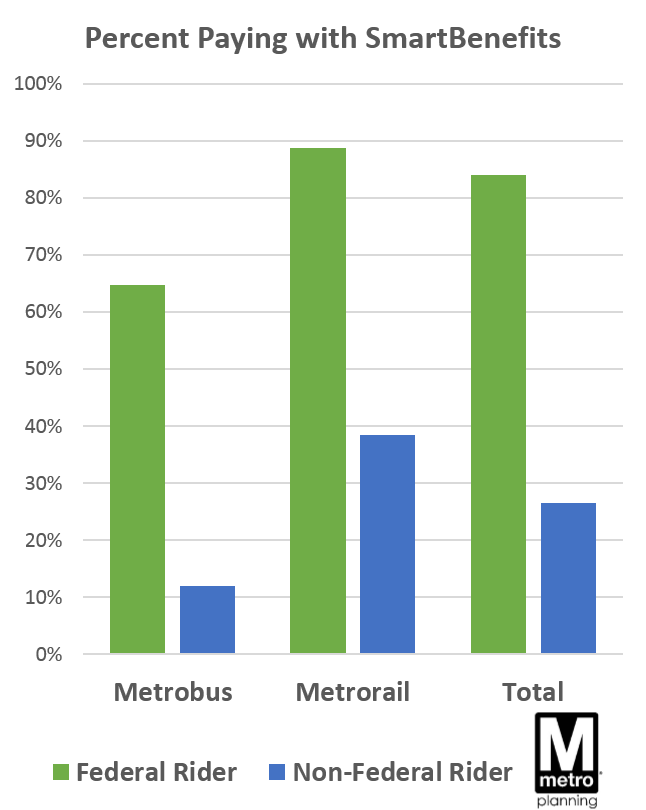How Metro’s Federal Customers Pay Fares, and Why It Matters (3 of 5)
Metro’s federal customers pay fares a little differently than other riders. Why is that such a big deal for Metro’s financial future?
(Third in a series of posts on Metro’s Federal customers – see posts 1 and 2)
 Compared to other riders, Metro’s federal customers are much more likely to pay their fare using SmartBenefits. SmartBenefits are the type of funds you load onto your SmarTrip card – usually through your employer, either as direct subsidy, or a certain amount of pre-tax dollars you set aside for transit fares. Metro riders in the Washington region may know the program manager WageWorks.
Compared to other riders, Metro’s federal customers are much more likely to pay their fare using SmartBenefits. SmartBenefits are the type of funds you load onto your SmarTrip card – usually through your employer, either as direct subsidy, or a certain amount of pre-tax dollars you set aside for transit fares. Metro riders in the Washington region may know the program manager WageWorks.
(Importantly, SmartBenefits is not exclusively a federal government benefit! On the contrary, non-federal workers are nearly half the overall enrollment in the SmartBenefits program, and 42% of Metro’s overall ridership comes from riders paying with SmartBenefits. We’ll make clear the difference between SmartBenefits and SmartTrip in an upcoming Metro 101 post – stay tuned.)
84% of federal employees on Metro pay their fare with SmartBenefits, compared to 27% of non-federal customers. In addition, federal customers tend to pay higher fares on rail – because federal workers typically take longer trips and ride more at peak times (average peak fare $3.00, vs. $2.87 non-federal customers).
Finally, 87% of Metro’s federal customers pay using “stored value” (pay-as-you-go funds), rather than a weekly or a monthly pass. Very few still use paper tickets or passes – but this is similar to other riders.
Why does this matter? It means that Metro’s ridership and revenue is very sensitive to actions by the Federal government. For example:
- When Congress cut the federal transit benefit maximum (the upper limit for your SmartBenefits) in half to $130/month in 2014, the 22% of Metro riders who spend over $130/month – many of whom are federal workers – were immediately impacted. To these riders, the drop in the transit benefit felt like a 20% fare hike, on average. And sure enough, in the ensuing months, we saw a decline in ridership from this customer market, particularly at the end of the month – at the same time we saw no loss from those not using SmartBenefits.
- When the Federal Government decides to close – for a snow day or a budget debate – Metro loses ridership, particularly at stations with high federal ridership. And because most are paying with stored value (pay as you go), Metro loses revenue as well. When the Federal Government closed in October 2013, ridership fell at nearly all stations by 10-20%, and by over 50% at some stations.
- When the Government locates federal offices and facilities near Metrorail, Metro gains ridership and revenue – see the recent gains at NoMa and Navy Yard, for example.
Coming up next – what are the recent trends in Metro ridership from federal employees? Where is this group growing or shrinking?


the 2 of 5 article disappeared.
“When the Federal Government decides to close – for a snow day or a budget debate – Metro loses ridership, particularly at stations with high federal ridership. And because most are paying with stored value (pay as you go), Metro loses revenue as well. When the Federal Government closed in October 2013, ridership fell at nearly all stations by 10-20%, and by over 50% at some stations.”
Monthly passes are the answer to this revenue loss. Adopting a pass system like Seattle’s PugetPass (http://www.soundtransit.org/sites/default/files/orca_product_list.pdf) would help make monthly passes useful for Metro riders regardless of the fare they pay. With this pass system, a rider can pick the fare value of their daily trip, and then all trips costing that value or less are free. For trips that cost more, the rider pays the difference from stored value.
@McKay
Thanks for catching that. We pulled it down to fix a Javascript issue with the embedded Tableau visualization. It will be back up by noon today.